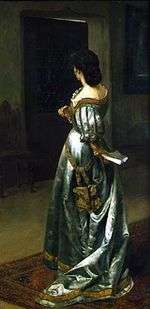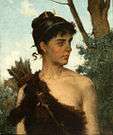Pedro Lira
.jpg)
Pedro Francisco Lira Rencoret (17 May 1845, Santiago – 20 April 1912, Santiago) was a Chilean painter and art critic, who organized exhibitions that led to the establishment of the Chilean National Museum of Fine Arts. He is best known for his eclectic portraits of women.
Biography
He was born into a wealthy family and his father was José Santos Lira Calvo, Minister of the Court of Appeals. His primary education was received at the Instituto Nacional General José Miguel Carrera. Pursuing an interest in art, he enrolled at the "Academia de Pintura", which was under the direction of Alejandro Ciccarelli, a noted Neoclassical painter from Italy.[1]

In 1862, he found a position in the workshop of Antonio Smith,[2] while studying law at the University of Chile. He graduated in 1867, but gave up his plans for a legal career to pursue painting instead.[3] In 1872, he won a medal at a competition celebrating the establishment of the Mercado Central de Santiago, organized by Benjamín Vicuña Mackenna.
Encouraged by this, he was able to obtain a grant to study in Europe, going there with his wife in the company of his friend and future brother-in-law, Alberto Orrego Luco.[2] Upon arriving in Paris, he found himself in the middle of an artistic battle between Neoclassicism and Romanticism, but did not take sides. After some thought, he chose Jules-Élie Delaunay to be his teacher.
He lived in France from 1873 to 1884 and was influenced by Eugene Delacroix, many of whose paintings he copied. Later, he received an "honorable mention" at the Salon, where little recognition was generally given to Latin American artists. But, despite his successes, he decided to return to Chile, as the time appeared ripe to create an artistic milieu comparable to that in Paris.
Activities in Chile
Soon after his arrival, he organized the first exposition devoted exclusively to Chilean painters. Together with the sculptor José Miguel Blanco, he founded the "Unión Artística",[3] an organization devoted to promoting more exhibitions and, ultimately, creating the Museo Nacional de Bellas Artes de Chile, which was originally located on the second floor of the National Congress Building. He also created a Salon, similar to the one in Paris, and helped establish a museum in the Quinta Normal, where expositions were held until 1910.
In 1892, he was appointed Director of the "Escuela de Bellas Artes", a position he held until his death.[2] While there, he was a mentor for promising new artists. Among the best known painters whose careers he supported are Pablo Burchard, Pedro Reszka Moreau and Celia Castro, the first Chilean woman to become a notable artist. He also compiled Chile's first "Biographical Dictionary of Painters"[1] and translated Hippolyte Taine's Philosophy of Art.[3] Several historical paintings of his have been used on Chilean banknotes.
Selected paintings
 On the Balcony
On the Balcony
 Woman of the People
Woman of the People Woman with Pins
Woman with Pins Gypsy Woman
Gypsy Woman
References
- 1 2 Brief biography @ MCN Biografías.
- 1 2 3 Brief biography by Patience Schell @ Relics and Selves.
- 1 2 3 Brief Biography @ Profesor en Línea.
Further reading
- Ana Francisca Allamand, Pedro Lira, El Maestro Fundador, Volume 6 of "Pintura chilena del siglo XIX", Origo Ediciones, 2008
External links
| Wikimedia Commons has media related to Pedro Lira. |
- Pedro Lira @ Artistas Plásticos Chilenos
- 500 Peso banknote, with reverse image after Pedro Lira, Banco Central de Chile
- Biographical Dictionary of Painters, complete text online @ Memoria Chilena
+ Google about Pedro Lira Rencoret